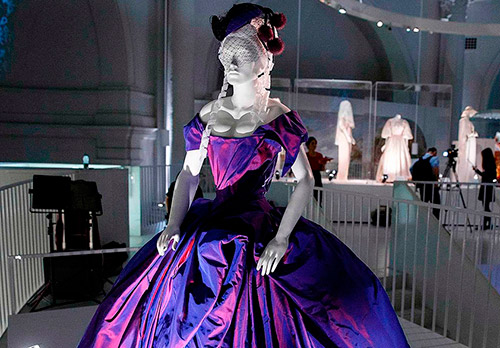Materials Science
Organza - fabric properties and care for organza products
Organza? (English organza) is a beautiful, tough, resilient and transparent fabric that is created by twisting silk, rayon or polyester fibers.
Organza, like many other luxurious fabrics, was brought to Europe from the East at the end of the 18th century. What is the origin of the term "organza"? There is no single answer to this question. According to one version, it is believed that the word came from the name of the American brand Logranza (1820), which produced various silk fabrics, according to the other, from the name of the ancient Uzbek city of Urgench (in Uzbek Urganch), where they were engaged in the production of natural silk.

Organza quickly gained popularity in all countries, and to this day, it remains among the luxurious and sought after fabrics. Organza was originally made from silk threads, and therefore belonged to the most expensive fabrics and could be used by the wealthiest women of fashion.
To create such a fabric required a lot of work - complex processing and high quality fibers. Therefore, organza was most often used to decorate clothes, collars and other elements were made from it. When polyester fibers appeared, organza became cheaper, while retaining its qualities.
And the qualities of this fabric are truly amazing, and this is due to the materials from which it is made, that is, silk, polyester or viscose. As part of modern organza - almost 100% polyester.
Organza, despite the fact that it is thin and transparent, has strength and even rigidity, which allows it to maintain its shape and practically not wrinkle. The airy fabric is incredibly pleasant to the touch: delicate, cool, smooth and weightless.
Depending on the processing, the fabric can be shiny or matte. Modern technologies have made it possible to create faceted transparent threads, and the material sparkled. It can shimmer with various rainbow shades, or it can be monochromatic or patterned. In the latter case, patterns can be printed, embroidered or perforated.

Organza properties
The properties of the fabric depend on the chemical composition of the fibers. These properties can be:
1. High strength.
2. Crease resistance.
3. High light transmission.
4. Great tensile strength.
5. Resistant to organic solvents.
6. Maintaining the original size and shape.
7. Organza is a durable and practical fabric.

The stiffness of the organza is caused by the tight twisting of the fibers. However, it should be noted that luxurious fabrics are difficult to cut. Before opening the organza, it is required to smooth it out, and this must be done with a dry iron, from the steam the fabric will become wavy.
During cutting, the material slips, therefore it is necessary to cut it on a fabric pad, having previously secured it with pins. It is necessary to translate the pattern using copy stitches. A carbon copy or a cogwheel is not suitable for organza.
When cutting, it is necessary, as always, to make allowances, but in the case of organza, they should be one and a half to two times larger than usual. The crumbling sections are processed with overlock or zigzag, can be sewn twice. During sewing, paper is placed under the fabric so that there is no slip.
When smoothing seams, you must do this carefully, after removing the pins and placing a cloth or tissue paper between the iron and the product. You should not press with an iron either. Ironing organza curtains is not an easy task, in this case they do not need to dry out. But the best option for curtains would be an organza-reaper or organza with appliqués.
Organza types
1. Organza chameleon is a fabric that changes color depending on the angle of incidence of light, which is due to the interweaving of threads of different colors in the warp and weft.
2. Organza rainbow - in this fabric there is a transition from one color to another. Multi-colored vertical stripes in this fabric smoothly change each other.
3. Organza Plated - Gold or silver plated fabric is great.
4. Organza with aluminum threads - the shiny fabric is extraordinarily good.
5. Crash Organza - Crash effect, crinkled fabric.
6. Organza can be either smooth or wrinkled, monochrome or colored. The patterns are printed or etched. The laser cut perforation is especially beautiful.
7. Embroidered organza is the most expensive.
There is no limit to the fantasies of chemists, technologists and designers. There is also an airy jacquard organza made of fibers of different thickness, composition and color.

Organza application
Organza is a fabric for a holiday. The material looks fabulously beautiful, and carries the joy and magic of a fairy tale. The beauty and variety of types of fabric makes it versatile.
Since the fabric is airy and weightless, curtains are made from it. The beauty of windows with such an outfit is indescribable. The curtains are transparent, sunlight passes through them well, they play with rainbow shades or embroidered patterns. Thin transparent fabric will decorate any room, create an atmosphere of soft uniform glow.
In addition to curtains, organza can be used as a bed for canopy, which will also create lightness, airiness and beautiful dreams in the interior of the bedroom.
Chic and elegant evening dresses will give you airy lightness and unique sophistication.
Delightful wedding dresses and theatrical outfits are sewn from organza.
Organza is an indispensable participant in the festive decoration of halls, in the creation of flower arrangements and bouquets.
From shining and iridescent shades of ribbons, wonderful bows are obtained and not only for a schoolgirl.
The beauty of organza flower arrangements attracts the attention of both needlewomen and fashionistas.
Organza is the most luxurious material for making exquisite gift wrapping.

Chloe
Material care
How to wash organza? Organza prefers hand wash most of all. To do this, curtains or other product should first be soaked in a warm solution of detergents for two hours, then rinsed slightly. You can wash on a delicate cycle without spinning. Then straighten the fabric and dry it with natural ventilation.
If the organza is white, then over time it can fade, like many white fabrics. To restore its snow-whiteness and splendor, you can bleach the fabric using special bleaches, or you can leave them overnight in salted water (two teaspoons of salt per five liters of cold water).
The best option in these cases may be dry cleaning.
Organza products can be washed in a washing machine on a delicate cycle with a temperature not exceeding 40 ° C. Wash by hand, without strong mechanical stress and active wringing, should only be fabrics with embroidery, sequins, beads and other decorative elements. In both cases, it is recommended to use liquid detergents. Chlorine bleach is not acceptable.

The lightly wrung-out product can be dried flat on a hanger. It is better to iron the product at the lowest iron temperature in a wet state, and from the inside out and through a thin cloth or paper. In any case, pay attention to the recommendations from the manufacturers.
This fabric is always in fashion, many designers love it, and women of fashion admire it. Organza is stunningly beautiful in the interior; an airy fabric can divide a room into different functional zones.
The fabric is able to create a transparent magic in the room, filling the space with sunlight, freshness and creating the feeling of transparent air. Organza will make a fabulous fairy out of any girl-bride. Organza flowers Is a delightful fantasy consisting of transparent air and a rainbow of shades.
Polyester fibers have made organza available to everyone. Viscose fabric and, moreover, it is difficult to find from natural silk. And it must be taken into account that the cost of these fabrics will be unlimited.

Tell friends:
Comments and Reviews
Add a comment
Similar materials
 Do-it-yourself beautiful organza flowers
Do-it-yourself beautiful organza flowers
 Beauty and properties of fabric - crepe-morocin
Beauty and properties of fabric - crepe-morocin
 Fashionable images of the reaper fabric and the properties of the fabric
Fashionable images of the reaper fabric and the properties of the fabric
 Changjang fabric - a luxurious palette of a chameleon
Changjang fabric - a luxurious palette of a chameleon
 Taffeta fabric - varieties and care
Taffeta fabric - varieties and care
 Viscose - the origin and properties of the fabric
Viscose - the origin and properties of the fabric
Rating news
Shades of clothing that make women look younger
What shades of hair make women younger: rules and photos
Funny wedding dresses - photos and ideas
12 most expensive down jackets for the winter
How to look 25 at 40: tips from supermodels
Beautiful schoolgirls
Anti-aging haircuts and hairstyles for women
Fashionable skirts for autumn and winter
Fashionable women's trousers for the cold season
Fashionable and stylish sandals for summer 2020
Spring-summer 2021
 Fashionable dresses and tops with thin spaghetti straps
Fashionable dresses and tops with thin spaghetti straps
 Bandana tops: how to wear stylishly and beautifully
Bandana tops: how to wear stylishly and beautifully
 How to put together the perfect men's wardrobe for the summer
How to put together the perfect men's wardrobe for the summer
 Trendy shorts for spring-summer 2021
Trendy shorts for spring-summer 2021
 Fashionable skirts for spring-summer 2021: a guide to online shopping
Fashionable skirts for spring-summer 2021: a guide to online shopping
 The most fashionable dresses spring-summer 2021: styles and colors
The most fashionable dresses spring-summer 2021: styles and colors
 Fashionable total look 2021: image ideas and trends
Fashionable total look 2021: image ideas and trends